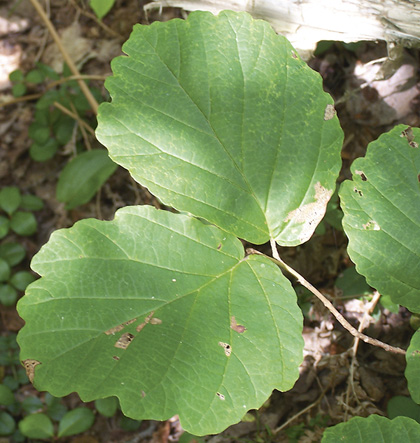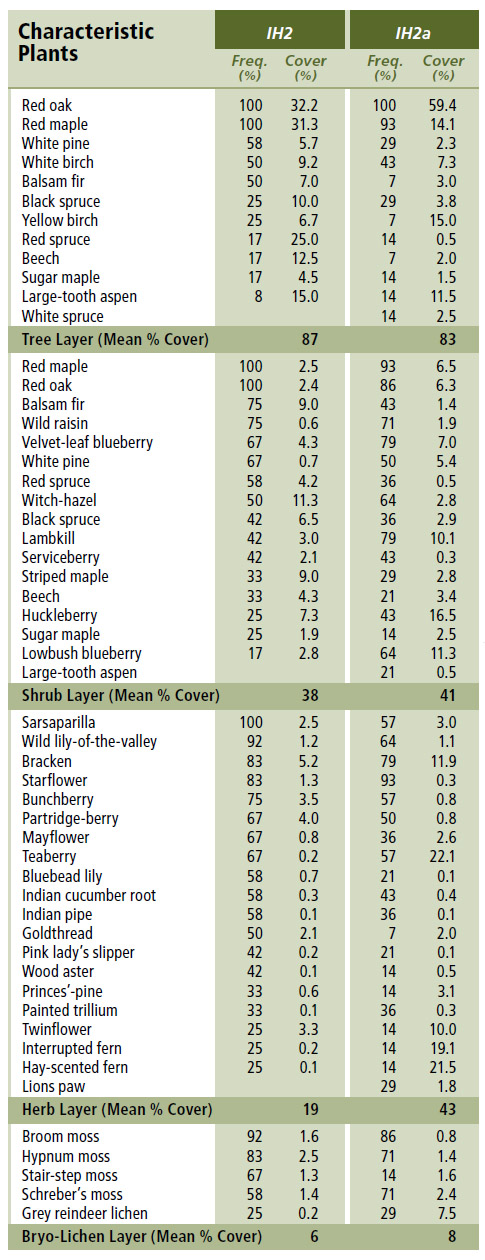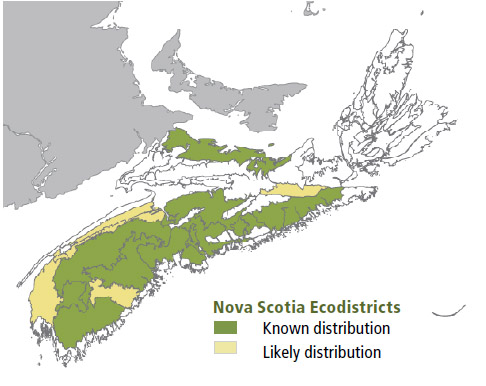
Forest Vegetation types - IH2
IH2 — Red oak – Red maple / Witch-hazel
Quercus rubra – Acer rubrum / Hamamelis virginiana
IH2a —Red oak variant
Quercus rubra
 |
Holden Lake, Lunenburg County |
Concept: This early to mid-successional Vegetation Type (VT) has a mixed hardwood overstory with a strong component of red oak. It is the prominence of red oak that distinguishes this unit from other intolerant hardwood VTs. Stands dominated by red oak are described by variant IH2a, a condition that possibly results from earlier fire and/or harvesting disturbances. Red oak – Red maple / Witch-hazel usually follows stand-replacing disturbance events and is almost exclusively a Western ecoregion VT. Sometimes embedded within an IH2 site is the woodland OW5 (Red oak / Huckleberry / Cow-wheat – Rice grass / Reindeer lichen).
Vegetation: Large-tooth aspen is the dominant overstory tree, but a variety of other species can also be found including red maple, sugar maple, yellow birch, white ash, balsam fir and red spruce (among others). The shrub layer is moderately developed and includes regenerating trees, fly-honeysuckle, serviceberry and wild raisin. The herb layer has many plants indicative of moist and/or fertile site conditions including interrupted fern, New York fern, sensitive fern, bladder sedge, Christmas fern, lady fern, oak fern and large-leaved aster. The bryophyte layer is poorly developed.
Environmental Setting: IH3 is mainly associated with fresh to moist, nutrient medium to rich soils of variable texture. This VT is found scattered throughout western and central Nova Scotia. IH3 is relatively uncommon across southern New Brunswick and on Prince Edward Island.
Successional Dynamics: Relatively dry, nutrient poor soils associated with this VT may lead to an edaphic climax community dominated by red oak, white pine and black spruce. Historically, stand maintaining fires would have reduced understory fuel loads and promoted red oak and possibly white pine presence until the overstory was destroyed by intense canopy fire. (Although the role of low intensity fires in red oak development is not well understood, it appears to be an important component of successional history in some stands.) IH2 can develop from IH1 (Large-tooth aspen / Lambkill / Bracken) stands and, once established, can maintain itself or transition to SP9 (Red oak – White pine / Teaberry). As the potential impacts of fire are reduced through management, IH2 could succeed to SP4 (White pine / Blueberry / Bracken) or on better sites to SH4 (Red spruce – White pine / Lambkill / Bracken).
Ecological Features:This early to mid-successional large patch forest occurs primarily in western Nova Scotia. Red oak is intermediate in shade tolerance and may occur in both the understory and overstory. This tree is a valuable mast producer for wildlife species including small mammals, bear, ruffed grouse and deer. Growth of oak regeneration may be enhanced by understory fire, which promotes vigorous sprouting from seedlings and saplings and gives them a competitive advantage. Red maple regenerates quickly as coppice and is a favoured browse by deer and moose. Mature red maple flower before most other spring plants, providing one of the most important early and abundant pollen and nectar sources for a wide range of insects. Oak is the preferred host of maitake (or hen-of-the-woods) mushroom.
 |
| Witch-hazel |
Distinguishing Features: This hardwood forest occurs on well drained, nutrient poor sites dominated by red oak and red maple. Ericaceous shrubs, as well as mayflower, teaberry, round leaf pyrola, bracken fern, pink lady's slipper and princes'-pine are common. Red oak is diagnostic for the variant IH2a.
| Slope Position: | Upper6 Middle3 Other1 |
Surface Stoniness: |
(Moderately)5 (Very - Excessively)4 (Non - Slightly)1 |
Bedrock Outcrop: |
(Non-rocky)8 (Slightly - Moderately)2 |
Elevation Range: |
11 - 184m |
Slope Gradient: |
Gentle7 Level1 Moderate1 nd1 |
Aspect: |
North1 East4 South2 West2 None1 |
Exposure: |
Moderate5 Mod. exposed5 |
Microtopography: |
Slightly4 Moderately4 Strongly2 |
Drainage: |
Well7 Moderately well2 Other1 |
Soil Type: |
ST24 ST2-G3 ST2-L2 ST61 nd1 |
Parent Material: |
Glacial till8 nd2 |
Rooting Depth (cm): |
(<30)1 (30-45)3 (>45)5 nd1 |
Duff Thickness (cm): |
(0-5)4 (6-10)3 (11-20)2 nd1 |

